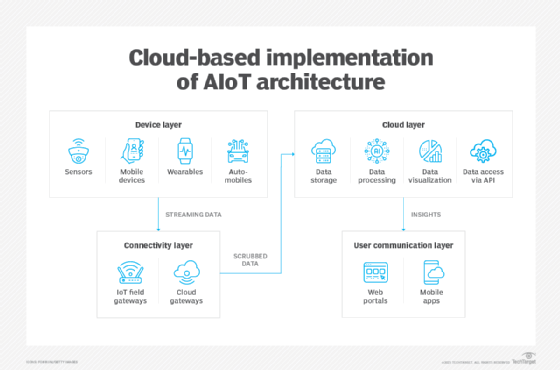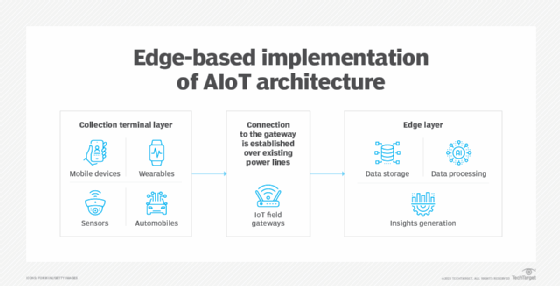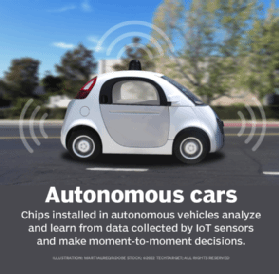What is the artificial intelligence of things (AIoT)?
The artificial intelligence of things (AIoT) is the combination of AI technologies and the internet of things (IoT) infrastructure. AIoT's goal is to create more efficient IoT operations, improve human-machine interactions, and enhance data management and analytics.
AI is the simulation of human intelligence processes by machines, especially computer systems, and typically uses specialized AI algorithms, along with natural language processing, machine learning speech recognition and machine vision.
IoT is a system of connected devices, mechanical and digital machines, or objects with unique identifiers with the ability to transfer data over a network without requiring human-to-human or human-to-computer interaction. For example, a thing in IoT can be a person's heart monitor implant, an automobile with built-in sensors to alert the driver when tire pressure is low, a personal assistant or any other object that can be assigned an Internet Protocol address and transfer data over a network.
Why is AIoT important?
Considering the capabilities AI can add to an IoT device or supporting network, think of adding AI as raising the performance bar on IoT technology. One of the key attributes of AI is its ability to automate tasks that would otherwise be performed manually.
A smart home, for example, has many of its functions -- e.g., security; entertainment; kitchen appliances; and heating, ventilation and air conditioning -- handled by an advanced smart device. Adding AI can help develop an all-encompassing smart home management system that, once programmed, offers performance that can literally schedule, administer and maintain all household activities, while providing an easy-to-use interface to the homeowner.
Smart personal assistants become logical extensions of their human owners, as they enable greater capabilities and flexibility in support of their daily activities.
How does AIoT work?
In AI IoT systems and devices, AI is embedded into infrastructure components, such as programs and chipsets, which are all connected using IoT networks. Application programming interfaces (APIs) are then used to ensure all hardware, software and platform components can operate and communicate without effort from the end user.
When operational, IoT devices create and gather data, which AI analyzes to provide insights and improve efficiency and productivity. Insights are gained when an AI system allows the use of processes such as data learning.
AIoT systems are generally designed and configured either as cloud-based or edge-based.
Cloud-based AIoT
Commonly referred to as IoT cloud, cloud-based IoT is the management and processing of data from IoT devices using cloud computing platforms. Connecting IoT devices to the cloud is essential since that's where data is stored, processed and accessed by various applications and services.
Cloud-based AIoT is composed of the following four layers:
- Device layer. This includes several types of hardware, including tags, beacons, sensors, cars, production equipment, embedded devices, and health and fitness equipment.
- Connectivity layer. This layer comprises fields and cloud gateways consisting of a hardware or software element that links cloud storage to controllers, sensors and other intelligent devices.
- Cloud layer. This consists of data processing via an AI engine, data storage, data visualization, data analysis and analytics, and data access via an API.
- User communication layer. This layer is made up of web portals and mobile applications.
Figure 1 depicts the architecture of cloud-based AIoT systems.

Edge-based AIoT
AIoT data can also be processed at the edge, meaning the data from IoT devices is processed as close to these devices as possible to minimize the bandwidth needed to move data, while avoiding possible delays to data analysis.
Edge-based AIoT consists of the following three layers:
- Collection terminal layer. This covers a range of hardware devices, such as embedded devices, cars, manufacturing equipment, tags, beacons, sensors, mobility devices, and health and fitness equipment, that are connected to the gateway over existing power lines.
- Connectivity layer. This consists of the field gateways that the collection terminal layer is connected to over existing power lines.
- Edge layer. This layer includes facilities for data storage, data processing and insight generation.
Figure 2 depicts an edge-based AIoT implementation.

Applications and examples of AIoT
Although many AIoT applications focus on the implementation of cognitive computing in consumer appliances, the following are several examples of the wider use of AIoT:

- Smart cities. Smart technology, such as sensors, lights and meters, collects data designed to improve operational efficiency, drive economic growth and improve residents' quality of life.
- Smart retail. Retailers use smart cameras to recognize shoppers' faces and detect if they've scanned their items at the self-checkout before leaving the store.
- Smart homes. Smart appliances learn through human interaction and response. AIoT appliances can also store and learn from user data to understand user habits to provide customized support.
- Smart office buildings. AI and IoT converge in smart buildings. Companies opt for a network of smart environmental sensors installed within their offices that detect the presence of people and automatically alter the lighting and temperature to maximize energy savings. In addition, facial recognition technology enables smart buildings to control access by using linked cameras and AI to compare live photos with a database to determine who gets access.
- Enterprise and industrial. Manufacturers use smart chips to detect when equipment isn't functioning properly or a part needs to be replaced.
- Social media and human resources (HR). AIoT tools can be integrated with social media and HR-related platforms to create an AI decision-as-a-service function for HR professionals.
- Autonomous vehicles. These vehicles, as noted in Figure 3, rely on multiple video cameras and sensor systems to gather data about nearby vehicles, monitor driving conditions and look for pedestrians.
- Autonomous delivery robots. Sensors gather data about the robot's environment -- for example, a warehouse -- and then use AI to make traversal-based decisions.
- Healthcare. Medical devices and wearables collect and monitor real-time health data, such as heart rate, and can detect irregular heartbeats.
- Wearable devices. Wearable technology can monitor and analyze personal health data to offer insights into a person's fitness, sleep and general well-being.
- Collaborative robots. Cobots are intended to assist people in the manufacturing and assembly of components. They aid humans in various tasks, such as product production, assembly, packaging and quality control, by using data from IoT devices and AI tools, including computer vision.
- City brains. City brains are intended to promote urban development by combining machine intelligence and real-time municipal data. For example, AIoT systems can process massive logs, videos and data streams from systems and sensors throughout an urban center to detect issues such as illegal parking, road accidents and changing traffic lights.
What are the benefits and challenges of AIoT?
Benefits of AIoT include the following:
- Increased operational efficiency. AI-integrated IoT devices can analyze data to reveal patterns and insights and adjust system operations to become more efficient.
- Ability to adjust on the fly. Data can be generated and analyzed to identify points of failure, which enable the system to make adjustments as needed.
- Data analytics. Employees don't have to spend as much time monitoring IoT devices, thus saving money.
- Scalability. The number of devices connected to an IoT system can be increased to optimize existing processes or introduce new features.
- Transformational technology. AIoT is transformational and mutually beneficial for both types of technology, as AI adds value to IoT through machine learning capabilities and improved decision-making processes. IoT adds value to AI through connectivity, signaling and data exchange. AIoT can improve businesses and their services by creating more value from IoT-generated data.
- Enhanced security. IoT devices can be susceptible to security risks. However, AI can identify and avert these risks since AI algorithms can analyze data from sensors to discover anomalies and potential security breaches. For example, AI can analyze security camera footage to spot suspicious activity and notify security staff.
- Reduced human error. Businesses lose millions of dollars each year as a result of human error. By integrating machine learning with IoT technology, organizations can effectively reduce errors. In normal workflows, data must pass through multiple phases or locations, creating more opportunities for human errors, such as data entry mistakes, to occur. AIoT mitigates these risks by analyzing information at its source. Minimizing data movement and reducing the number of intermediaries involved decrease the chances of errors significantly.
- Personalization. While IoT devices can gather information about user preferences and behavior, AI can use this information to further tailor user experiences. For example, a smart speaker can use AI to learn a user's musical preferences and generate customized playlists automatically.
Along with its benefits and use cases, there are also instances where AIoT could fail, causing a backup in production or other negative consequences. For example, autonomous delivery robots that fail might cause a delay in the delivery of a product; smart retail stores could fail to read a customer's face, leading to the customer accidentally stealing a product; or an autonomous vehicle might fail to read its surroundings, such as an oncoming stop sign, and cause an accident.
The following are some additional challenges associated with AIoT:
- Cybersecurity issues. The growing number of devices connected through AIoT increases the risk of cyberattacks and security breaches.
- Complexity. IoT and AI technology integration can be challenging and demand particular knowledge and abilities.
- Data management concerns. Effective data management strategies are required for processing the data gathered from various sensors.
- High cost. Implementing AIoT technologies can be costly due to the need for specialized equipment, software and employees.
- Privacy concerns. There are concerns about how data acquired by AIoT devices is handled and stored, which could result in privacy issues and violations.
Standards and regulations that impact AIoT
Currently, the universe of activity associated with AIoT is governed by several standards, regulations and frameworks that ensure safety, privacy and ethical deployment.
The following is a list of key initiatives.
AIoT regulatory initiatives
- European Union (EU) AI Act. This 2024 legislation establishes a regulatory framework for AI systems, including AIoT.
- EU Cyber Resilience Act. This 2024 legislation addresses the implementation of cybersecurity on AI-based products.
- General Data Protection Regulation. This important 2016 EU legislation protects the collection and processing of personal data.
- Network and Information Security Directive 2. This EU directive, launched in 2023, provides guidance on cybersecurity for numerous digital systems, including IoT.
- California IoT Security Law. This 2020 legislation requires device manufacturers to provide security features and unique passwords in consumer IoT devices.
- U.S. IoT Cybersecurity Improvement Act. This 2020 legislation establishes cybersecurity standards for IoT devices.
AIoT standards and frameworks
| Standard/Framework | Purpose |
| ISO/IEC 27001 (2022) | Fundamental standard for implementing an information security management system |
| ISO/IEC 22989 (2022) | Framework and terminology for AI system development |
| ISO/IEC 23894 (2023) | Guidance for managing risks associated with AI |
| NIST SP 800-213 (2021) | Guidance on cybersecurity for IoT devices |
| NIST AI Risk Management Framework (2023) | Framework providing guidance on how to design and develop AI systems with a focus on managing risks |
| IEEE P7000 Series | Guidance on ethical considerations in the development of advanced technology systems, such as IoT |
| U.S. FCC Cyber Trust Mark (2024) | Voluntary labeling for secure consumer IoT products |
What is the future of AIoT?
With the integration of AI, IoT creates a much smarter system. The goal is to have these systems make accurate judgments without the need for human intervention.
Digital transformation and the collaboration between AI and IoT have the potential to tap into unrealized customer value in several industry verticals, including edge analytics, autonomous vehicles, personalized fitness, remote healthcare, precision agriculture, smart retail, predictive maintenance and industrial automation.
Popular and emerging trends of AIoT include the following:
- Edge computing. This technology focuses on processing data in proximity to its source instead of relying on centralized cloud servers, offering benefits such as decreased latency, enhanced efficiency and reduced network congestion.
- Swarm intelligence. Swarm intelligence involves the coordinated behavior of decentralized and self-organized systems. Inspired by natural swarms, such as bees or ants, this technology can be applied to optimize the functioning of IoT devices.
- 5G technology. One of the bigger possible innovations in AIoT is the inclusion of 5G. 5G is designed to enable faster transfer of large data files in IoT devices through its higher bandwidth and lower latency.
- Operational efficiencies. AIoT could help solve existing operational problems, such as the expense associated with effective human capital management or the complexity of supply chains and delivery models.
- Computer vision. The goal of computer vision is to make machines comprehend and interpret visual information gleaned from the real production environment. It can analyze video streams from cameras, recognize objects and spot anomalies in AIoT applications, enabling in-the-moment automation, monitoring and optimization. Computer vision is revolutionizing the industrial sector, especially in the context of Industry 4.0, by empowering companies to improve operational efficiency, implement quality control procedures, enhance preventive maintenance practices and prioritize worker safety measures.
- Smarter cities. Within urban environments, extensive use of AIoT improves vehicular traffic management, lighting, waste collection and public safety.
- Enhanced simulations using digital twins. The creation of digitized replicas of physical systems helps identify potential system failures, while enhancing overall performance.
- AI-enhanced cybersecurity. AI has been demonstrating how it can greatly enhance the prevention, detection and mitigation of cyberthreats.
- Enhanced environmental sustainability. AIoT built into systems impacting the environment is expected to reduce energy consumption, improve resource usage and achieve goals for the environment and sustainability.
IoT can provide numerous benefits to businesses but can be challenging to deploy. Learn the prerequisites and best practices for a successful IoT installation.







